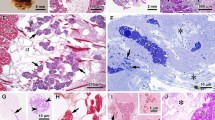Summary
The oyster brown cell, a connective tissue cell of uncertain function and affinity, was characterized in the electron microscope by (1) the presence of large cytoplasmic granules, (2) fenestrations of the plasma membrane, and (3) an extensive tubular network originating in, or emptying into, the plasma membrane fenestrations. The brown cell did not appear to be a cell involved in glycogen storage or in the manufacture of “exportable” protein. The extensive tubular network and the membrane slits suggested that the brown cell may have been involved in the processing of biological fluids.
Similar content being viewed by others
References
Cheng, T. C., Burton, R. W.: Relationships between Bucephalus sp. and Crassostrea virginica: histopathology and sites of infection. Chesapeake Sci. 6, 3–16 (1965).
—, Rifkin, E.: The occurrence and resorption of Tylocephalum metacestodes in the clam, Tapes semidecussata. J. Invert. Path. 10, 65–69 (1968).
Friede, R. L.: The relation of the formation of lipofuscin to the distribution of oxidative enzymes in the human brain. Acta neuropath. (Berl.) 2, 113–125 (1962).
Grassé, P. P.: Traité de zoologie: Anatomie, systématique, biologie, vol. 5(2), p. 2009–2019. Paris: Masson & Cie. 1960.
Haigler, S. A.: A histochemical and cytological study of the “brown cells” found in “auricular pericardial gland” and other tissues of the oyster, Crassostrea virginica (Gmelin). Master's thesis, University of Delaware, 1964.
Issidorides, M.: Some evidence of the contribution of neuronal lipofuscin in the phenomena of tissue regeneration. Regeneration in animals and related problems (eds. Kortsis, V., and H. A. Trampusch), p. 500–505. Amsterdam: North-Holland Publ. Co. 1965.
Luft, J. H.: Improvements in epoxy resin embedding methods. J. biophys. biochem. Cytol. 9, 409–415 (1961).
Mackin, J. G.: Histopathology of infection of Crassostrea virginica by Dermocystidium marinum. Bull. Mar. Sci. Gulf and Caribb. 1, 72–87 (1951).
Newman, G., Kerkut, G. A.: The structure of the brain of Helix aspera. Electron microscope localization of cholesterol and amines. Studies in the structure, physiology, and ecology of molluscs (ed. Fretter, U.), p. 1–17. Zool. Soc. Lond. Symp. 22. New York: Academic Press 1968.
Reynolds, E. S.: The use of lead citrate at high pH as an electron-opaque stain in electron microscopy. J. Cell Biol. 17, 208–213 (1963).
Rifkin, E., Cheng, T. C., Hohl, H. R.: An electron-microscope study of the constitutents of encapsulating cysts in the American oyster, Crassostrea virginica, formed in response to Tylocephalum metacestodes. J. Invert. Path. 14, 211–226 (1969).
Ruddell, C. L.: A cytological and histochemical study of wound repair in the Pacific oyster, Crassostrea gigas. Ph. D. thesis, Univ. of Washington, 1969.
Stein, J. E., Mackin, J. G.: A study of the nature of the pigment cells of oysters and the relation of their numbers to the fungus disease caused by Dermocystidium marinum. Tex. J. Sci. 7, 422–429 (1955).
Takatsuki, S.: On the nature and function of the amebocytes of Ostrea edulis. Quart. J. micr. Sci. 76, 379–436 (1934).
Toth, S. E.: The origin of lipofuscin age pigments. Exp. Geront. 3, 19–30 (1968).
White, K. M.: The pericardial cavity and the pericardial gland of the Lamellibranchia. Proc. Malacol. Soc. (Lond.) 25, 37–88 (1942).
Author information
Authors and Affiliations
Additional information
This work was supported in part by Public Health Service Contract No. 5 To 1 ES00038-02, Health Sciences Advancement Award No. RR06138, and Tumor Biology Training Grant, NIH CA 05245.
We wish to thank Miss Grete Nilsen for her expert technical assistance and Mr. Bob Munn for his help in the use of the electron microscope and for proof reading our MS. Our appreciation is also extended to Dr. J. Luft, Dr. A. K. Sparks, Miss P. Phelps, Mr. M. DeVault, and to the personnel of the Johnson Oyster Company, Inverness.
Rights and permissions
About this article
Cite this article
Ruddell, C.L., Wellings, S.R. The ultrastructure of the oyster brown cell, a cell with a fenestrated plasma membrane. Z. Zellforsch 120, 17–28 (1971). https://doi.org/10.1007/BF00331241
Received:
Issue Date:
DOI: https://doi.org/10.1007/BF00331241




